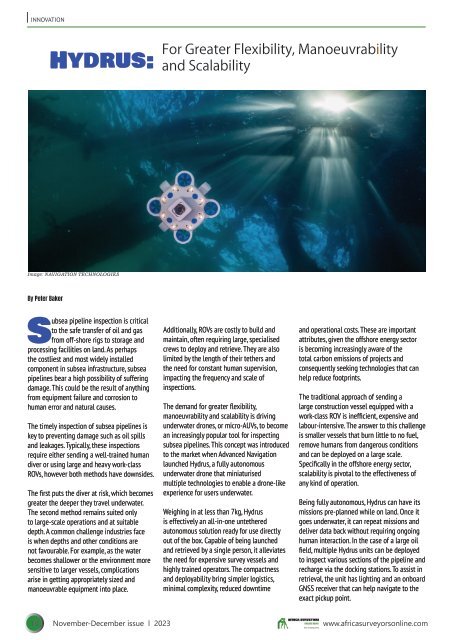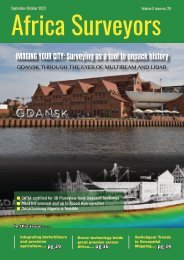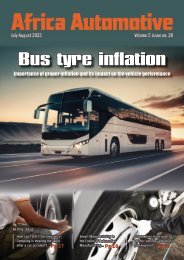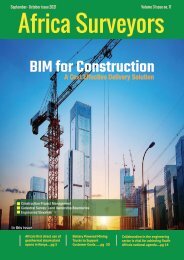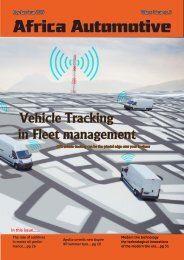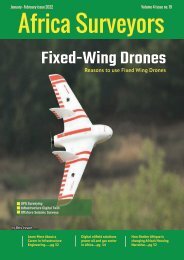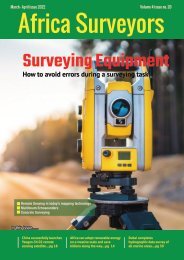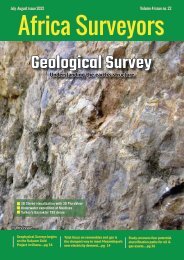Africa Surveyors November-December issue 2023
Africa Surveyors is Africa’s premier source of Surveying, Mapping and Geospatial news and an envoy of surveying products/service for the Construction, Maritime, Onshore & Offshore energy and exploration, Engineering, Oil and Gas, Agricultural and Mining sectors on new solution based trends and technology for the African market.
Africa Surveyors is Africa’s premier source of Surveying, Mapping and Geospatial news and an envoy of surveying products/service for the Construction, Maritime, Onshore & Offshore energy and exploration, Engineering, Oil and Gas, Agricultural and Mining sectors on new solution based trends and technology for the African market.
Create successful ePaper yourself
Turn your PDF publications into a flip-book with our unique Google optimized e-Paper software.
INNOVATION<br />
Hydrus:<br />
For Greater Flexibility, Manoeuvrability<br />
and Scalability<br />
Image: NAVIGATION TECHNOLOGIES<br />
By Peter Baker<br />
Subsea pipeline inspection is critical<br />
to the safe transfer of oil and gas<br />
from off-shore rigs to storage and<br />
processing facilities on land. As perhaps<br />
the costliest and most widely installed<br />
component in subsea infrastructure, subsea<br />
pipelines bear a high possibility of suffering<br />
damage. This could be the result of anything<br />
from equipment failure and corrosion to<br />
human error and natural causes.<br />
The timely inspection of subsea pipelines is<br />
key to preventing damage such as oil spills<br />
and leakages. Typically, these inspections<br />
require either sending a well-trained human<br />
diver or using large and heavy work-class<br />
ROVs, however both methods have downsides.<br />
The first puts the diver at risk, which becomes<br />
greater the deeper they travel underwater.<br />
The second method remains suited only<br />
to large-scale operations and at suitable<br />
depth. A common challenge industries face<br />
is when depths and other conditions are<br />
not favourable. For example, as the water<br />
becomes shallower or the environment more<br />
sensitive to larger vessels, complications<br />
arise in getting appropriately sized and<br />
manoeuvrable equipment into place.<br />
Additionally, ROVs are costly to build and<br />
maintain, often requiring large, specialised<br />
crews to deploy and retrieve. They are also<br />
limited by the length of their tethers and<br />
the need for constant human supervision,<br />
impacting the frequency and scale of<br />
inspections.<br />
The demand for greater flexibility,<br />
manoeuvrability and scalability is driving<br />
underwater drones, or micro-AUVs, to become<br />
an increasingly popular tool for inspecting<br />
subsea pipelines. This concept was introduced<br />
to the market when Advanced Navigation<br />
launched Hydrus, a fully autonomous<br />
underwater drone that miniaturised<br />
multiple technologies to enable a drone-like<br />
experience for users underwater.<br />
Weighing in at less than 7kg, Hydrus<br />
is effectively an all-in-one untethered<br />
autonomous solution ready for use directly<br />
out of the box. Capable of being launched<br />
and retrieved by a single person, it alleviates<br />
the need for expensive survey vessels and<br />
highly trained operators. The compactness<br />
and deployability bring simpler logistics,<br />
minimal complexity, reduced downtime<br />
and operational costs. These are important<br />
attributes, given the offshore energy sector<br />
is becoming increasingly aware of the<br />
total carbon emissions of projects and<br />
consequently seeking technologies that can<br />
help reduce footprints.<br />
The traditional approach of sending a<br />
large construction vessel equipped with a<br />
work-class ROV is inefficient, expensive and<br />
labour-intensive. The answer to this challenge<br />
is smaller vessels that burn little to no fuel,<br />
remove humans from dangerous conditions<br />
and can be deployed on a large scale.<br />
Specifically in the offshore energy sector,<br />
scalability is pivotal to the effectiveness of<br />
any kind of operation.<br />
Being fully autonomous, Hydrus can have its<br />
missions pre-planned while on land. Once it<br />
goes underwater, it can repeat missions and<br />
deliver data back without requiring ongoing<br />
human interaction. In the case of a large oil<br />
field, multiple Hydrus units can be deployed<br />
to inspect various sections of the pipeline and<br />
recharge via the docking stations. To assist in<br />
retrieval, the unit has lighting and an onboard<br />
GNSS receiver that can help navigate to the<br />
exact pickup point.<br />
18 <strong>November</strong>-<strong>December</strong> <strong>issue</strong> l <strong>2023</strong> www.africasurveyorsonline.com


